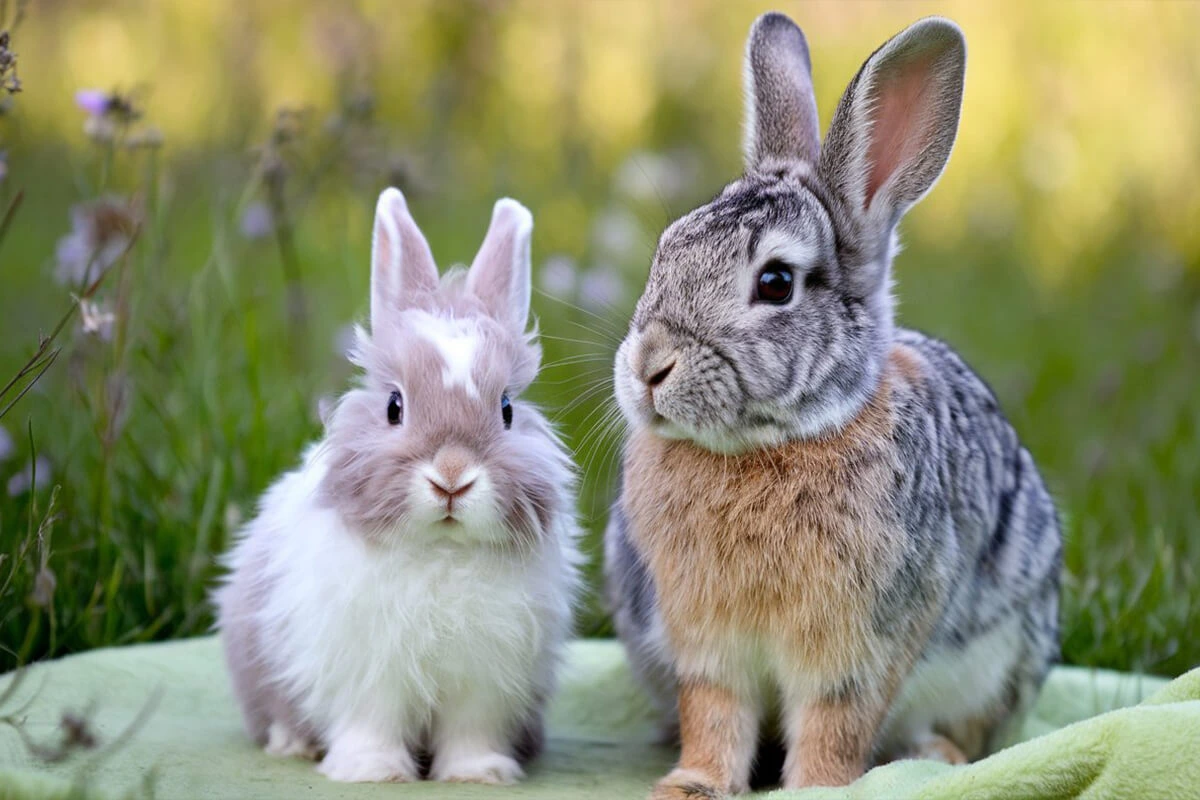Many people often wonder about the difference between bunny vs rabbit size when considering a pet. The terms “bunny” and “rabbit” are used interchangeably, but they don’t always mean the same thing. A bunny usually refers to a baby or small rabbit, while a rabbit is the general term for the species, including both young and fully grown individuals. Understanding the size differences between bunnies and rabbits is essential for choosing the right pet that fits your lifestyle and living space.
Size plays a crucial role in a rabbit’s care, diet, housing needs, and overall lifespan. Some breeds, like the tiny Netherland Dwarf, stay small their entire lives, while others, such as the Flemish Giant, grow to an impressive size. The difference in size impacts how much space they need, what they eat, and how much attention they require.
Before deciding whether a bunny or a rabbit is the right pet for you, it’s important to consider factors like available space, maintenance, and commitment. A small rabbit may be easier to manage in an apartment, while a larger breed requires more room to roam. This guide will break down the key differences in size, growth, and care needs, helping you make the best decision when choosing your perfect pet.
Understanding the Difference Between Bunny and Rabbit Size
What is a Bunny?
A bunny is often used as a cute, informal term for a rabbit, especially baby rabbits or smaller-sized breeds. When people say “bunny,” they usually picture a tiny, fluffy animal with big eyes and twitching whiskers. However, the term doesn’t refer to a specific species or breed—it’s simply a nickname for rabbits, particularly young ones.
Baby rabbits, also called kits or kittens, are born blind, hairless, and completely dependent on their mothers. As they grow, they develop fur, open their eyes, and start hopping around. Many small rabbit breeds, such as the Netherland Dwarf and Holland Lop, are commonly referred to as bunnies even when fully grown because of their petite size and adorable appearance.
When considering bunny vs rabbit size, remember that a bunny isn’t a separate type of rabbit—it’s just a term people use to describe young rabbits or smaller breeds.
What is a Rabbit?
A rabbit is the correct term for the species that includes all domestic and wild rabbits, regardless of age or size. Rabbits come in a wide range of breeds, from tiny, lightweight varieties to large, heavy ones. Unlike “bunny,” which typically refers to young or small rabbits, the word “rabbit” applies to all sizes and life stages.
Domestic rabbits, such as the Holland Lop, Mini Rex, and Flemish Giant, vary greatly in size. Some breeds stay under 3 pounds when fully grown, while others, like the Flemish Giant, can weigh over 15 pounds. Rabbits can live indoors as pets or outdoors in secure hutches, depending on their size and care requirements.
When choosing between a bunny vs rabbit size, it’s essential to understand that a bunny is just a term for a small or young rabbit, while a rabbit refers to the entire species.
Bunny vs Rabbit Size Comparison
The biggest difference in bunny vs rabbit size comes down to growth and breed variation. While baby rabbits start small, their adult size depends on genetics. Some bunnies stay tiny even as adults, while others grow into large, sturdy rabbits.
Here’s a quick comparison of bunny vs rabbit size:
- Baby Bunnies (Kits): Typically weigh a few ounces at birth and fit in the palm of your hand.
- Small Rabbit Breeds (e.g., Netherland Dwarf, Mini Rex): Weigh between 2 to 4 pounds as adults.
- Medium Rabbit Breeds (e.g., Holland Lop, Dutch Rabbit): Weigh around 4 to 7 pounds as adults.
- Large Rabbit Breeds (e.g., Flemish Giant, Checkered Giant): Can grow over 15 pounds and reach the size of a small dog.
The choice between a bunny vs rabbit size depends on your lifestyle. A small bunny may be easier to care for in an apartment, while a larger rabbit needs more space, food, and maintenance. Understanding these differences helps future pet owners make the best decision when bringing a rabbit into their home.
How Big Do Bunnies and Rabbits Get?
Rabbit Growth Stages
Rabbits go through distinct growth stages, and their size changes significantly as they mature. Understanding these stages helps pet owners provide the right care at each phase of development.
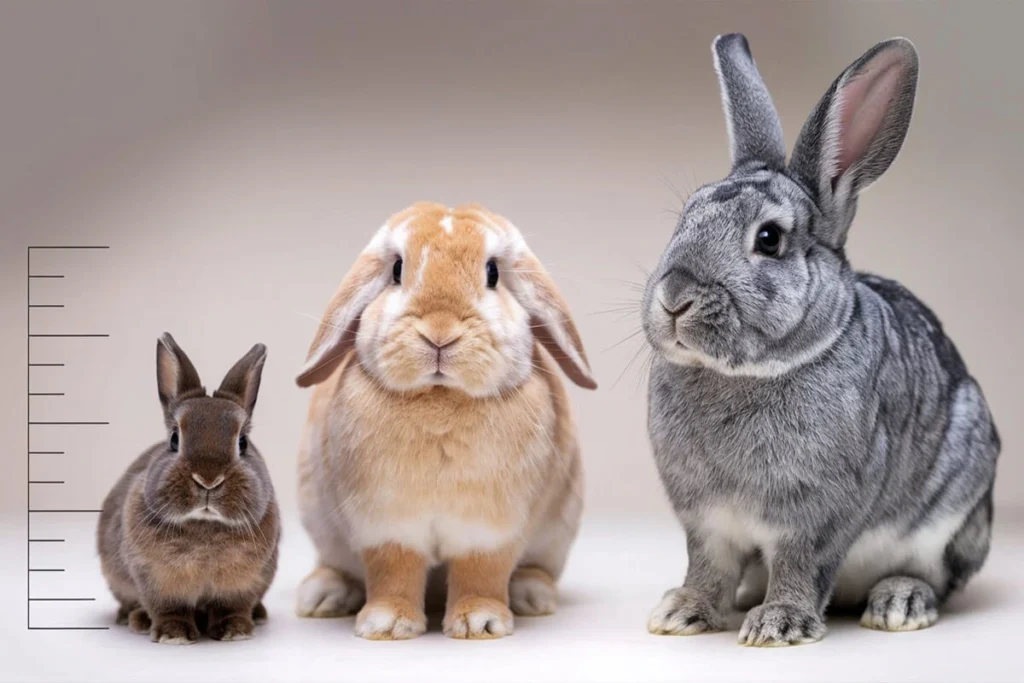
- Newborn (0-2 weeks) – Baby rabbits, also called kits, are born blind, hairless, and completely dependent on their mother’s milk. They weigh just a few ounces and stay in the nest for warmth and protection.
- Juvenile (3-8 weeks) – Fur begins to grow, and their eyes open around 10 days old. By 3 weeks, they start nibbling on solid food while still nursing. By 8 weeks, they are fully weaned and ready to be independent.
- Young Rabbit (2-6 months) – This is a rapid growth phase where they develop muscle and bone structure. Small breeds reach their full size faster, while larger breeds continue growing for several more months.
- Adult Rabbit (6 months and older) – Most rabbits reach their full size between 6 and 12 months, though larger breeds like the Flemish Giant may continue growing until they are 1.5 to 2 years old.
Monitoring growth and providing a balanced diet ensures proper development, whether you have a small or large rabbit breed.
Factors Affecting Rabbit Size
Several factors determine how big a rabbit will grow. While genetics play the biggest role, diet, environment, and breed characteristics also influence size.
- Breed Genetics – A rabbit’s breed determines its potential size. Small breeds like the Netherland Dwarf stay under 3 pounds, while large breeds like the Flemish Giant can exceed 15 pounds.
- Diet and Nutrition – A rabbit’s growth depends on a balanced diet of hay, fresh vegetables, and pellets. Poor nutrition can stunt growth, while overfeeding can lead to obesity.
- Exercise and Activity Levels – Rabbits need daily exercise to develop strong bones and muscles. Larger breeds require more space and movement to stay healthy.
- Living Conditions – Rabbits that live in clean, stress-free environments with proper space and ventilation grow healthier and reach their full size potential.
Understanding these factors helps pet owners provide the best care for their rabbits, ensuring they grow strong and healthy.
Rabbit Size Chart
Rabbits come in different sizes depending on their breed. This chart provides a general comparison of rabbit sizes to help potential pet owners choose the right fit for their home.
- Small Breeds (2-4 lbs) – Netherland Dwarf, Polish Rabbit, Mini Rex
- Medium Breeds (4-7 lbs) – Holland Lop, Dutch Rabbit, Mini Lop
- Large Breeds (8-12 lbs) – Rex Rabbit, English Lop, Silver Fox
- Giant Breeds (12+ lbs) – Flemish Giant, Checkered Giant, Continental Giant
Choosing the right rabbit size depends on lifestyle, available space, and care commitment. Smaller breeds require less space and food, while larger breeds need roomy enclosures and more maintenance. Whether adopting a bunny or a full-grown rabbit, understanding size differences ensures a better match for both pet and owner.
Choosing Between a Bunny or Rabbit as a Pet
Small Rabbit Breeds vs Large Rabbit Breeds
Rabbit breeds come in a wide range of sizes, from tiny, lightweight bunnies to large, heavy rabbits. Understanding the differences between small rabbit breeds and large rabbit breeds helps future pet owners choose a pet that fits their lifestyle and space.
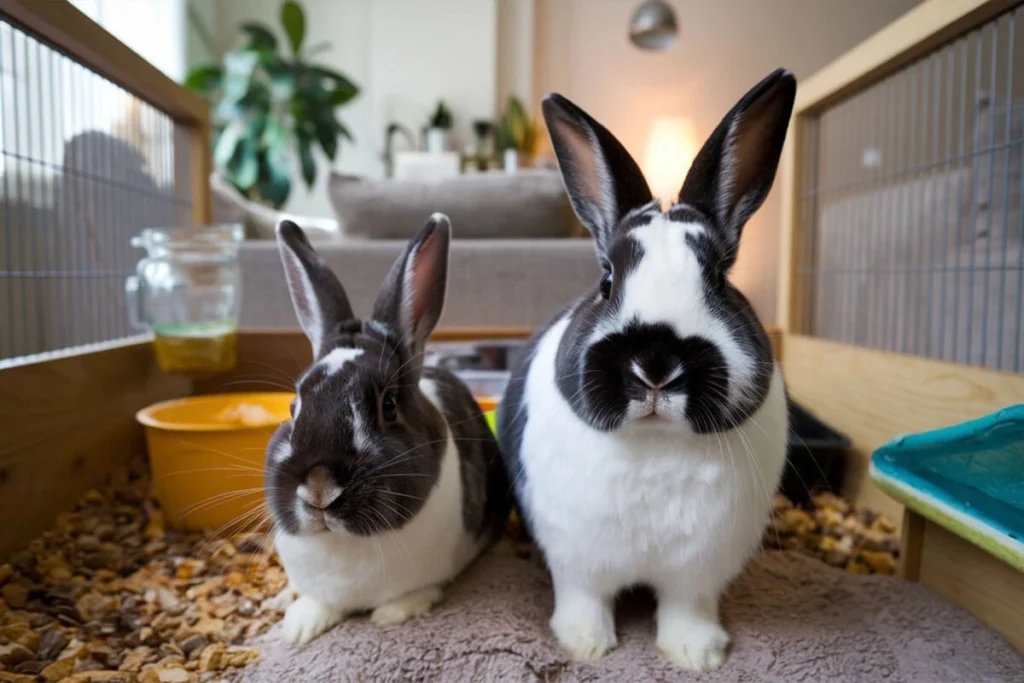
- Small Rabbit Breeds (2-4 lbs) – These rabbits are compact, energetic, and require less space. Popular breeds include the Netherland Dwarf, Mini Rex, and Holland Lop. Small rabbits are ideal for apartment living, but they can be more fragile and require gentle handling.
- Medium Rabbit Breeds (4-7 lbs) – These rabbits strike a balance between small and large breeds. Examples include the Dutch Rabbit, Mini Lop, and English Spot. They are manageable in size while still having a sturdy build.
- Large Rabbit Breeds (8-12 lbs) – These breeds, like the Rex Rabbit and English Lop, require more space but are often calmer and more affectionate. They make great indoor or outdoor pets but need a well-sized enclosure.
- Giant Rabbit Breeds (12+ lbs) – Breeds like the Flemish Giant and Continental Giant can grow as large as a small dog. They have gentle personalities but need ample space, a strong enclosure, and a higher food supply.
Choosing between a small rabbit breed and a large rabbit breed depends on factors like available space, handling preferences, and long-term care commitment.
Space and Housing Needs
The size of a rabbit determines how much space it needs to live comfortably. Whether keeping a bunny or a full-grown rabbit, providing the right living environment is crucial for their well-being.
- Indoor Rabbits – Small and medium-sized rabbits adapt well to indoor living. They need a spacious enclosure (at least 4×2 feet) with soft bedding, a litter box, and room for exercise. Free-roaming rabbits need a rabbit-proofed home to prevent chewing on wires or furniture.
- Outdoor Rabbits – Larger breeds thrive in outdoor hutches or enclosures, but the space must be secure, weatherproof, and protected from predators. A rabbit run with at least 8-12 square feet of space allows for proper movement.
- Exercise and Play Areas – Regardless of size, rabbits need at least 3-4 hours of exercise outside their enclosure daily. A larger rabbit requires more space to hop and stretch comfortably.
Providing the right space ensures that rabbits stay healthy, active, and mentally stimulated, whether they are small or large breeds.
Pet Bunny vs Rabbit Care Considerations
Caring for a small bunny vs a large rabbit comes with different responsibilities. While both require love and attention, their specific needs vary based on size.
- Dietary Needs – All rabbits need unlimited hay, fresh vegetables, and pellets, but larger rabbits consume more food. A Flemish Giant, for example, eats significantly more than a Netherland Dwarf.
- Grooming Requirements – Small rabbits often require frequent grooming, especially fluffy breeds like the Lionhead Rabbit. Larger rabbits with short fur may need less frequent brushing but require more care for their large ears and nails.
- Handling and Socialization – Small bunnies can be delicate and harder to hold, making them better suited for gentle owners. Large rabbits are heavier and need proper support when lifted to avoid injury.
- Veterinary Care and Lifespan – Small breeds generally live longer, around 10-12 years, while giant breeds have shorter lifespans of 5-8 years. Regular vet checkups, vaccinations, and dental care are essential for all rabbits.
Whether choosing a bunny or a full-grown rabbit, understanding their specific needs helps pet owners provide the best care. Matching a rabbit’s size with your ability to provide proper housing, diet, and socialization ensures a happy and healthy pet.
Caring for a Pet Rabbit: Size-Based Care Tips
Diet and Nutrition Based on Rabbit Size
A rabbit’s diet plays a crucial role in its health, and bunny vs rabbit size affects how much food they need. While all rabbits require a balanced diet, their portion sizes vary based on breed and weight.
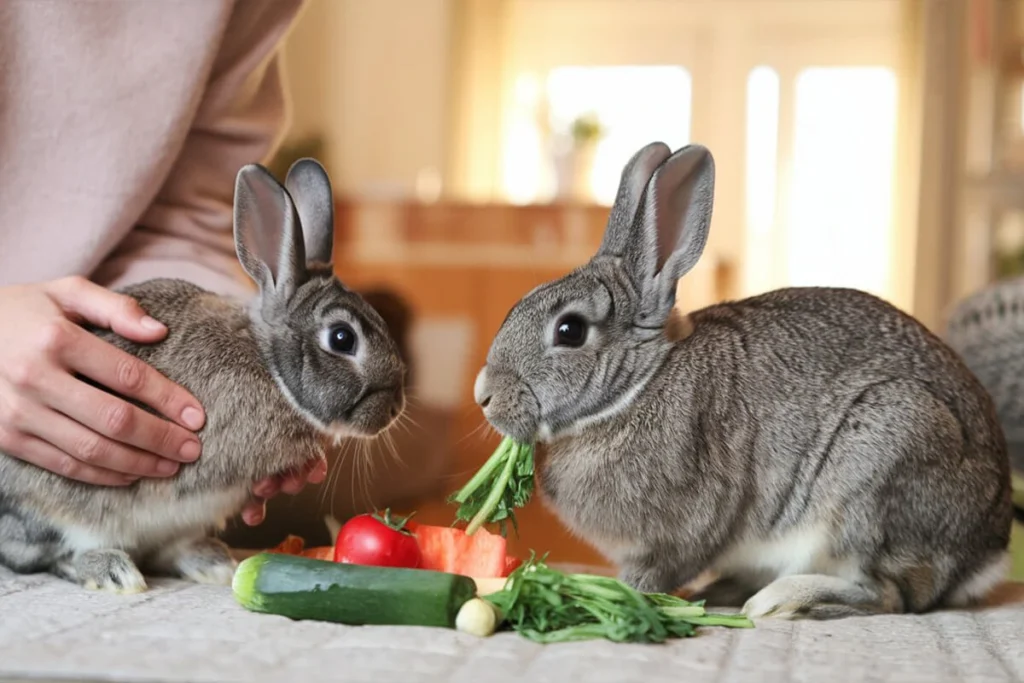
- Hay (Unlimited for All Rabbits) – The foundation of every rabbit’s diet is high-quality hay, such as Timothy, Orchard, or Meadow hay. Small and large rabbits alike need constant access to hay to support digestion and prevent dental issues.
- Pellets (Size-Based Portions) – Small rabbits, like the Netherland Dwarf, require 1/8 to 1/4 cup of pellets per day, while larger breeds, such as the Flemish Giant, may need up to 1 cup daily. Overfeeding pellets can lead to obesity, especially in indoor rabbits with limited exercise.
- Fresh Vegetables (Portioned for Size) – Leafy greens, such as romaine lettuce, cilantro, parsley, and kale, should make up about 10-15% of a rabbit’s daily intake. Small breeds need about 1 cup of greens daily, while giant breeds may eat 2-4 cups per day.
- Treats and Fruits (Limited Amounts) – Rabbits love treats, but too much sugar can cause digestive issues. Offer small portions of carrots, apples, or bananas (no more than 1-2 teaspoons) based on size.
Understanding diet and nutrition based on rabbit size helps owners provide the right portions, ensuring their pet stays healthy and active.
Housing and Cage Considerations
Providing the right housing for a bunny or a full-grown rabbit is essential for comfort and well-being. The size of the enclosure must match the rabbit’s size, allowing for movement, stretching, and play.
- Small Rabbits (2-4 lbs) – A minimum cage size of 4×2 feet works well for breeds like the Mini Rex or Holland Lop, but larger enclosures or free-roaming setups are better.
- Medium Rabbits (4-7 lbs) – These rabbits need at least a 6×2 foot space inside their enclosure, with a playpen or rabbit-proofed area for exercise.
- Large Rabbits (8+ lbs) – Giant breeds, such as the Flemish Giant, need a minimum of 8 square feet of enclosure space, plus a larger run area for daily exercise. Outdoor hutches should be predator-proof and weather-resistant.
- Multi-Rabbit Housing – If keeping more than one rabbit, double the recommended space. Rabbits are social animals but need enough room to avoid territorial disputes.
Choosing the right rabbit housing and cage setup ensures that your pet has a safe, comfortable environment that meets its needs.
Exercise and Playtime Needs
Rabbits are active animals that require daily exercise and playtime to stay healthy. A rabbit’s size determines how much space and movement they need.
- Small Rabbits – Breeds like the Netherland Dwarf can exercise in indoor playpens or rabbit-proofed rooms. They need at least 3 hours of free-roaming time daily.
- Medium Rabbits – These rabbits need 4-5 hours of supervised playtime in a safe indoor or outdoor space. Medium-sized breeds are more social and benefit from interactive toys.
- Large and Giant Rabbits – Big breeds like the Checkered Giant require at least 5-6 hours of exercise daily. They need spacious play areas to hop freely and avoid muscle stiffness.
Providing exercise and playtime ensures rabbits stay active, prevents boredom, and reduces health issues like obesity or muscle weakness. Whether you have a small bunny or a large rabbit, regular movement is key to a happy, healthy pet.
Final Tips on Picking the Perfect Rabbit for You
Matching Rabbit Size to Your Lifestyle
Choosing between a small bunny or a large rabbit depends on your lifestyle, living space, and daily routine. Rabbits of different sizes have varying care needs, space requirements, and personalities.
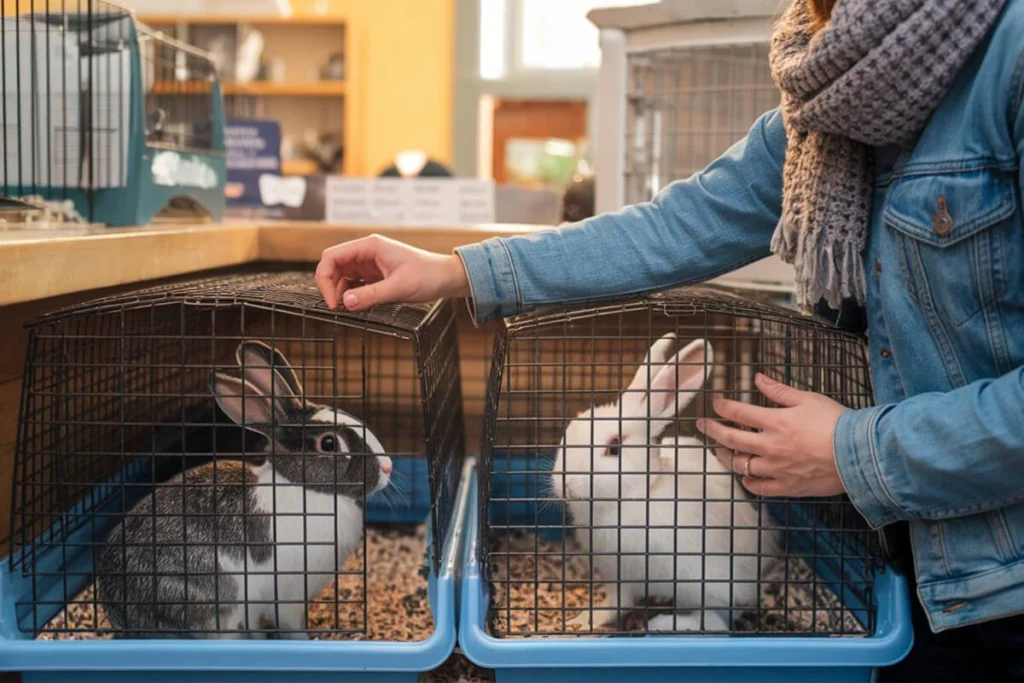
- Small Rabbits (2-4 lbs) – Ideal for apartment living, small rabbits like the Netherland Dwarf or Mini Rex require less space and food. However, they are delicate and require gentle handling, making them better suited for adults or older children.
- Medium Rabbits (4-7 lbs) – These rabbits, such as the Holland Lop and Mini Lop, balance size and care needs. They are easy to handle, need a moderate-sized enclosure, and can adapt well to both small and large homes.
- Large Rabbits (8+ lbs) – Giant breeds like the Flemish Giant or Checkered Giant require significant space and food, making them more suitable for homes with large play areas or outdoor enclosures. Their calm temperament makes them great for families, but they are heavier to lift and require strong cages.
If you have limited space, a small rabbit may be the best fit. If you have a spacious home and can commit to extra care, a large rabbit can be a wonderful companion. Matching rabbit size to your lifestyle ensures both you and your pet are comfortable and happy.
Rabbit Lifespan and Long-Term Commitment
Rabbits can live for many years, making them a long-term commitment. Their lifespan depends on breed, size, and care quality.
- Small Rabbits – Small breeds like the Netherland Dwarf often live the longest, typically 10-12 years. Proper diet, exercise, and veterinary care can extend their lifespan.
- Medium Rabbits – These rabbits, such as the Holland Lop, live 8-10 years on average with good care.
- Large and Giant Rabbits – Large breeds like the Flemish Giant have shorter lifespans, usually 5-8 years. Their size makes them more prone to joint issues and heart problems.
Owning a rabbit is a decade-long responsibility that includes providing proper diet, space, veterinary care, and social interaction. Before adopting, consider whether you can commit to caring for a rabbit for its full lifespan.
Adopting vs Buying a Pet Rabbit
When deciding to bring a rabbit into your home, you can either adopt from a shelter or rescue or buy from a breeder or pet store. Each option has pros and cons.
- Adopting a Rabbit
- Gives a home to a rabbit in need.
- Many shelters provide spayed/neutered and vaccinated rabbits.
- Adoption costs are usually cheaper than buying a pet from a breeder.
- Rabbits may already be socialized and litter-trained.
- Buying from a Breeder or Pet Store
- Allows for selecting a specific breed, size, and age.
- Reputable breeders ensure good health and genetic history.
- Can be more expensive, especially for rare breeds.
- Pet stores often sell rabbits without full health guarantees.
Adoption is the best choice for most people, as it helps reduce the number of homeless rabbits while still allowing owners to find a great pet. However, if you’re looking for a specific breed or size, a reputable breeder is a good option. Whether adopting or buying, research carefully to ensure a happy and healthy rabbit.
Conclusion
Choosing between a bunny vs rabbit size depends on your lifestyle, space, and ability to provide proper care. Understanding the difference between bunny and rabbit size helps potential pet owners make an informed decision. Small rabbits, like the Netherland Dwarf, require less space and food but need careful handling due to their delicate size. Large rabbits, such as the Flemish Giant, offer affectionate companionship but need more room, food, and veterinary care to stay healthy.
A bunny size vs rabbit size comparison also highlights the importance of considering factors like diet, housing, exercise, and long-term commitment. Rabbits grow through different stages, and their final size depends on their breed, genetics, diet, and environment. Checking a rabbit size chart before adopting helps match the right rabbit to your home and lifestyle.
Beyond size, caring for a pet rabbit requires proper nutrition, a spacious enclosure, regular exercise, and veterinary checkups. Whether adopting a bunny or a full-grown rabbit, responsible pet ownership means committing to their needs for 5 to 12 years. Adoption remains a great option for finding a loving rabbit, but if purchasing from a breeder, researching responsible breeders ensures a healthy pet.
Ultimately, selecting a rabbit should go beyond appearance. Consider their size, behavior, care requirements, and lifespan before bringing one home. Whether you choose a small bunny or a large rabbit, providing the right environment ensures a happy, healthy, and long-lasting bond with your pet.
Choose The Cutest Name for your Cat Or Bunny From our Top 20 Cute Names Here.
Who Is Faster Between Hare Vs Rabbit Speed? Find Out Now!
Find The Best Care Tips For All Different Cats From HERE.
Looking For Some Good stuff for your Pet? Look no Further and pay Pet MD Official a Visit.
